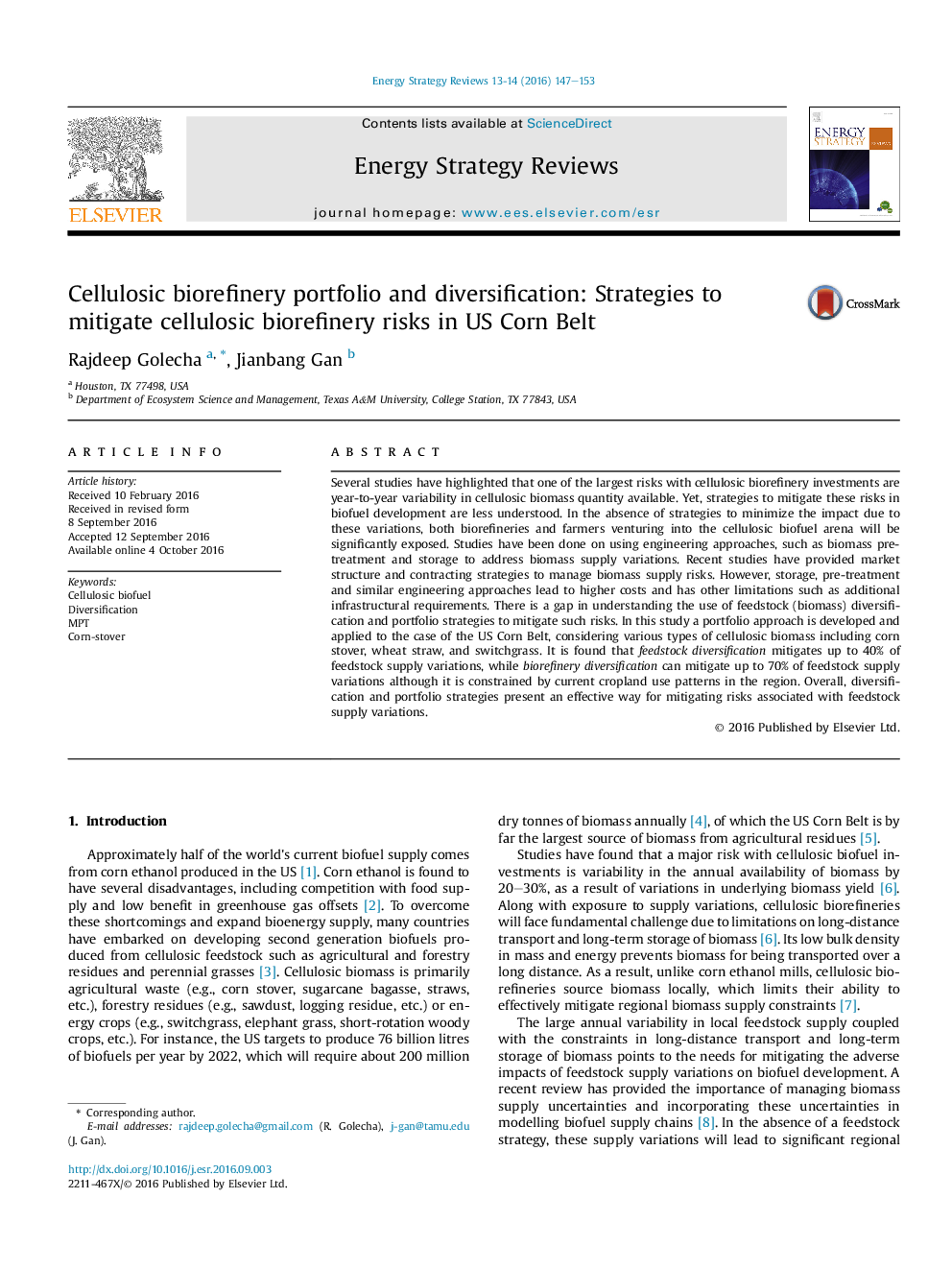| کد مقاله | کد نشریه | سال انتشار | مقاله انگلیسی | نسخه تمام متن |
|---|---|---|---|---|
| 6481311 | 1483526 | 2016 | 7 صفحه PDF | دانلود رایگان |
عنوان انگلیسی مقاله ISI
Cellulosic biorefinery portfolio and diversification: Strategies to mitigate cellulosic biorefinery risks in US Corn Belt
ترجمه فارسی عنوان
نمونه کارها و متنوعی از کارخانه های زیستی سلولزیک: راهکارهایی برای کاهش خطرات زیستی سلولزی در کمربند ذرت ایالات متحده
دانلود مقاله + سفارش ترجمه
دانلود مقاله ISI انگلیسی
رایگان برای ایرانیان
ترجمه چکیده
مطالعات متعدد نشان داده است که یکی از بزرگترین خطرات با سرمایه گذاری های سلولز بیورفینینگ، تغییرات سالانه در سال در مقدار بیومس سلولز موجود است. با این وجود، استراتژی هایی برای کاهش این خطرات در توسعه سوخت های زیستی کمتر درک شده است. در غیاب راهکارهایی برای به حداقل رساندن تأثیر ناشی از این تغییرات، هر دو گیاهان زراعی و کشاورزان که در عرصه سوخت زیستی سلولز قرار دارند، به طور قابل توجهی در معرض قرار می گیرند. مطالعات انجام شده در زمینه استفاده از روش های مهندسی مانند پیش پردازش زیست توده و ذخیره سازی برای مقابله با تغییرات عرضه زیست توده انجام شده است. مطالعات اخیر ساختار بازار و راهبردهای قرارداد را برای مدیریت خطرات عرضه زیست توده ارائه داده اند. با این حال، روش های ذخیره سازی، پیش درمان و روش های مهندسی مشابه به هزینه های بالاتر منجر می شود و دارای محدودیت های دیگر مانند نیازهای زیربنایی اضافی است. شکاف در درک استفاده از تنوع زیست توده (زیست توده) و استراتژی های نمونه کارها برای کاهش چنین خطرات وجود دارد. در این مطالعه، رویکرد نمونه کارها در مورد کمربند ذرت ایالات متحده، با توجه به انواع مختلف زیست توده سلولی، از جمله ذرت، کاه گندم و زغال سنگ، مورد استفاده قرار گرفته است. مشخص شده است که تنوع مواد اولیه سبب کاهش 40 درصد تغییرات عرضه مواد اولیه می شود، در حالی که تنوع زیستی می تواند تا 70 درصد از تغییرات عرضه مواد اولیه را کاهش دهد، گرچه با استفاده از الگوهای فعلی کشاورزی در این منطقه محدود شده است. به طور کلی، تنوع و استراتژی های نمونه کارها، یک راه موثر برای کاهش خطرات مربوط به تغییرات عرضه مواد اولیه هستند.
موضوعات مرتبط
مهندسی و علوم پایه
مهندسی انرژی
انرژی (عمومی)
چکیده انگلیسی
Several studies have highlighted that one of the largest risks with cellulosic biorefinery investments are year-to-year variability in cellulosic biomass quantity available. Yet, strategies to mitigate these risks in biofuel development are less understood. In the absence of strategies to minimize the impact due to these variations, both biorefineries and farmers venturing into the cellulosic biofuel arena will be significantly exposed. Studies have been done on using engineering approaches, such as biomass pre-treatment and storage to address biomass supply variations. Recent studies have provided market structure and contracting strategies to manage biomass supply risks. However, storage, pre-treatment and similar engineering approaches lead to higher costs and has other limitations such as additional infrastructural requirements. There is a gap in understanding the use of feedstock (biomass) diversification and portfolio strategies to mitigate such risks. In this study a portfolio approach is developed and applied to the case of the US Corn Belt, considering various types of cellulosic biomass including corn stover, wheat straw, and switchgrass. It is found that feedstock diversification mitigates up to 40% of feedstock supply variations, while biorefinery diversification can mitigate up to 70% of feedstock supply variations although it is constrained by current cropland use patterns in the region. Overall, diversification and portfolio strategies present an effective way for mitigating risks associated with feedstock supply variations.
ناشر
Database: Elsevier - ScienceDirect (ساینس دایرکت)
Journal: Energy Strategy Reviews - Volumes 13â14, November 2016, Pages 147-153
Journal: Energy Strategy Reviews - Volumes 13â14, November 2016, Pages 147-153
نویسندگان
Rajdeep Golecha, Jianbang Gan,
